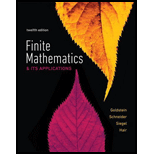
Three-Sector Economy An economy consists of the three sectors agriculture, energy, and manufacturing. For each $1 worth of output, the agriculture sector requires $.08 worth of input from the agriculture sector, $.10 worth of input from the energy sector, and $.20 worth of input from the manufacturing sector. For each $1 worth of output, the energy sector requires $.15 worth of input from the agriculture sector, $.14 worth of input from the energy sector, and $.10 worth of input from the manufacturing sector. For each $1 worth of output, the manufacturing sector requires $.25 worth of input from the agriculture sector, $.12 worth of input from the energy sector, and $.05 worth of input from the manufacturing sector.
(a) Give the input–output matrix A for this economy.
(b) Determine the matrix
(c) At what level of output should each sector produce to meet a demand for $4 billion worth of agriculture, $3 billion worth of energy, and $2 billion worth of manufacturing?
(d) How much of the output of each sector is used to meet internal consumption?
Want to see the full answer?
Check out a sample textbook solution
Chapter 2 Solutions
Finite Mathematics & Its Applications (12th Edition)
- 1 -1- Ο Graph of f y = + y = 1 + 1/2 ·2· x Graph of g y = 1- 플 The figure gives the graphs of the functions f and g in the xy-plane. The function of is given by f(x) = tan¹ x. Which of the following defines g(x)? A tan 1 x + 1 B - tan 1 x + П 2 C tan-1 (2/2) + 1 D tan-1 (2/2) + 1/1arrow_forwardIn Problems 10-4, use the method of undetermined coefficients to determine the form of a particular solution for the given equation.arrow_forwardIn Problems 10-40, use the method of undetermined coefficients to determine the form of a particular solution for the given equation. 2 1. y"" - 2y" - 5y/+6y= e² + x²arrow_forward
- match the equation to it's respective directional field in the image, justify your answer a. dy/dx=x-1 b. dy/dx=1 - y^2 c. dy/dx=y^2 - x^2 d. dy/dx=1-x e. dy/dx=1-y f. dy/dx=x^2 - y^2 g. dy/dx=1+y h. dy/dx=y^2 - 1arrow_forward4. The runway at the Piarco International airport has an equation of -3(x-2y) = 6. If the Priority Bus Route passes through the geometric coordinate (1,-9) and is perpendicular to the runway at the Piarco International airport. Determine the following: a. State two geometric coordinates which the runway at the Piarco International airport passes through. b. Derive the equation of the Priority Bus Route. [2 marks] [6 marks]arrow_forwardUse Euler and Heun methods to solve y' = 2y-x, h=0.1, y(0)=0, compute y₁ys, calculate the Abs_Error.arrow_forward
- TY D om E h om ng 00 C B A G F Q ו 3 13 Details Find an Euler path for the graph. Enter your response as a sequence of vertices in the order they are visited, for example, ABCDEA. fic ► Question Help: Video Message instructor Submit Question tor arch 園 A Wind advisoryarrow_forwardThe twice differentiable functions fand g are defined for all real numbers of x. Values of f(x) and g(x) for various values of x are given in the table below. Evaluate (f'(g(x))g'(x)dx. -2 X -2 −1 1 3 f(x) 12 8 2 7 g(x) -1 03 1arrow_forwardSuppose we wish to test the hypothesis that women with a sister’s history of breast cancer are at higher risk of developing breast cancer themselves. Suppose we assume that the prevalence rate of breast cancer is 3% among 60- to 64-year-old U.S. women, whereas it is 5% among women with a sister history. We propose to interview 400 women 40 to 64 years of age with a sister history of the disease. What is the power of such a study assuming that the level of significance is 10%? I only need help writing the null and alternative hypotheses.arrow_forward
- Q4*) Find the extremals y, z of the the functional I = 1 (2yz - 2x² + y²² 12 - 212) dx, with y(0) = 0, y(1) = 1, z(0) = 0, ≈(1) = 0.arrow_forwardSolve the following initial value problem over the interval from t= 0 to 2 where y(0)=1. dy yt² - 1.1y dt Using Euler's method with h=0.5 and 0.25.arrow_forwardQ5*) Write down an immediate first integral for the Euler-Lagrange equation for the integral I = = F(x, y, y″) dx. Hence write down a first integral of the Euler-Lagrange equation for the integral I 1 = √(xy ² + x³y²) dx. Find the general solution of this ordinary differential equation, seeking first the complementary function and then the particular integral. (Hint: the ODE is of homogeneous degree. And, for the particular integral, try functions proportional to log x.)arrow_forward
 College AlgebraAlgebraISBN:9781305115545Author:James Stewart, Lothar Redlin, Saleem WatsonPublisher:Cengage LearningAlgebra & Trigonometry with Analytic GeometryAlgebraISBN:9781133382119Author:SwokowskiPublisher:Cengage
College AlgebraAlgebraISBN:9781305115545Author:James Stewart, Lothar Redlin, Saleem WatsonPublisher:Cengage LearningAlgebra & Trigonometry with Analytic GeometryAlgebraISBN:9781133382119Author:SwokowskiPublisher:Cengage
 Linear Algebra: A Modern IntroductionAlgebraISBN:9781285463247Author:David PoolePublisher:Cengage Learning
Linear Algebra: A Modern IntroductionAlgebraISBN:9781285463247Author:David PoolePublisher:Cengage Learning Big Ideas Math A Bridge To Success Algebra 1: Stu...AlgebraISBN:9781680331141Author:HOUGHTON MIFFLIN HARCOURTPublisher:Houghton Mifflin Harcourt
Big Ideas Math A Bridge To Success Algebra 1: Stu...AlgebraISBN:9781680331141Author:HOUGHTON MIFFLIN HARCOURTPublisher:Houghton Mifflin Harcourt Algebra: Structure And Method, Book 1AlgebraISBN:9780395977224Author:Richard G. Brown, Mary P. Dolciani, Robert H. Sorgenfrey, William L. ColePublisher:McDougal Littell
Algebra: Structure And Method, Book 1AlgebraISBN:9780395977224Author:Richard G. Brown, Mary P. Dolciani, Robert H. Sorgenfrey, William L. ColePublisher:McDougal Littell





